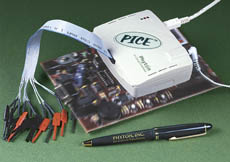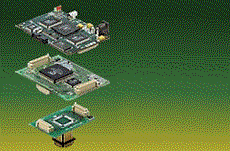 |
| |
Phyton PICE-52 In-Circuit Emulator (ICE) for the 8051 Microcontroller Family |
|
|
|
|
|
| |
The PICE-52 In-Circuit Emulator (ICE) is a high-end In-Circuit Emulator (ICE) which supports emulation of many 8051 Microcontroller derivatives. The emulator has many advanced features including Real-time, non-intrusive emulation, multiple hardware breakpoints and "on-the-fly" access to the code memory, shadow memory, breakpoints, tracer and timer
The PICE-52 is a Palm size 3-1/2" x 2-1/2" x 2" (95 x 65 x 50 mm), "sandwich-style" emulator header which plugs directly into a target device socket and consists of three small boards: Emulator Main Board, POD and Package Adapter. |
| |
|
|
 |
Main Emulator Board |
|
|

|
- The main emulator board is available in several types which support different options of speed and memory size.
-
To choose the correct main board for your emulator, please choose the [Main Board] option link from either [System Contents] or [Associated Products].
|
 |
Emulator POD |
|
|

|
- The Emulator Pod board must be chosen to compliment the choice of main board combined with the family of microcontroller which you wish to emulate.
-
Please see the [Associated Products] section for a list of the available PODS for this emulator.
|
 |
Emulator Adaptor |
|
|

|
- The Adaptor Board connects the emulator POD to the device socket on the Target Board.
-
A wide range of Adaptor Boards are available to suit all the possible package types of the Target Device.
-
To choose the correct Adaptor Board for your emulator, please follow the links for the Adaptor in either [Associated Products] or [System contents].
|
 |
Emulation |
|
- Real-time non-intrusive emulation for most of popular 8051 derivatives with internal and external memory.
-
1.8V to 5.5V voltage range for the target MCU.
-
Transparent emulation - access "on the fly" (viewing and modifying) to all main emulator resources.
-
Single step and Step over for both C and assembly instructions; Run, Run to address, Auto step (animation) modes
-
Completely programmable via the software - no switches and jumpers on the boards
-
Software programmable switching from one clock mode to other (for example from 12- to 6-clock mode and back)
|
 |
Design |
|
- No boxes, no plug-in PC boards, no heavy ribbon cable!
-
Palm size 95x70x50 mm (about 3 1/2"x2-3/4"x2"), "sandwich-style" emulator header enclosed into a plastic case which plugs directly into the target socket
-
Precisely centered emulator header secures durable contact between the package adapter and the target socket
|
 |
Programmable Clock |
|
- Precisely programmable clock generator allows setting any frequency from 5 KHz to 80 MHz with 1 Hz resolution and .5% accuracy.
-
Clock can be received either from the emulator internal generator or the target board.
|
 |
Memory |
|
- Up to 2M emulation program memory with 256 bytes mapping resolution.
-
Up to 512K emulation Xdata memory with 256 bytes mapping resolution.
-
Dual-ported emulator memory enables real-time memory access without disturbing program execution
-
Shadow RAM feature allows to display memory contents during real-time emulation when a full memory space is distributed between the emulator (internal) and target (external) RAM
-
Memory banking feature allows to support up to 32 banks by 64K each
|
 |
Trace Buffer |
|
- Real-time trace buffer with "view-on-the-fly" feature - up to 64K frames deep and 128 bits wide (16K by 128 bits by default)
-
Tracing of address, data, control lines, time stamps and 8 external inputs
-
Several modes of trace recording: synchronous, forward, reverse and dynamic
-
Programmable trace filters and advanced search capability
-
48-bit real-time timer for precise time stamping
-
Code coverage feature - shows which program and data memory locations have been accessed and have not been accessed by an application program.
|
 |
Breakpoints |
|
- Up to 1M true hardware breakpoints at Program memoryand memory access breakpoints
-
Up to 1M true hardware breakpoints at Xdata memory access for Read, Write and both R&W
-
Breakpoints on access to on-chip data memories: SFRs, direct data memory, on-chip Xdata, and EEPROM
-
4 x complex (conditional) breakpoints/triggers, each of which can be individually set as a combination of the address, data, status of 8 external inputs, bus width and access type.
-
Intelligent breakpoint processor operates with 4 trigger outputs generating signals for stopping emulation or for trace recording without disturbing real-time running. The contents of the real-time timer, true event counters, tracer frame counter and tracer overflow flag can be involved in control of the breakpoint processor
-
Simple and intuitive breakpoint processor programming via graphical logic schemes
|
 |
Inputs/Outputs, Interface and Power Management |
|
- 8 logic inputs (micro miniature hooks)
-
4-trigger output for synchronization of external lab equipment and switching memory banks
-
USB and opto isolated RS-232C interface to a PC. Up to 115KBaud connection via RS-232C.
-
Precise MCU controlled voltage regulator provides two power management modes: a) follow the target level or b) set any value from 1.2V to 5.5V
-
5V/1A power wall adapter is included. The emulator can also use the target system's power.
|
 |
Software Support |
|
- The PICE debugger operates under Windows® 3.1/9X/2000/NT/XP
-
Built-in MCA-51 macro assembler
-
Built-in intelligent disassembler and on-line assembler for quick code patches.
-
Project-52 IDE allows editing, compiling, error localization/correction, project management, debugging in one friendly organized development environment for the embedded MCA-51 assembler and most popular C compilers from Keil, Raisonance and IAR.
-
Source and symbol debugging for C compilers and assemblers from Keil, IAR, TASKING, Raisonance, Hi-Tech, Crossware, Intel and others
-
Uploading and downloading files in the binary, Intel HEX, and absolute formats.
-
Windows supported: Source/Edit, Disassembler, Project, Messages, Watches, AutoWatches, Inspector, Memory dump, Memory Layout, Peripheral (target specific), Execution time, Tracer, Console, Caller Stack, Script source, User, I/O stream, Timing diagrams, Code Coverage
-
AutoWatches window and the AutoWatches pane of the Source window display all variable names within a current scope refreshing them after every program step.
-
Peripheral windows are target-dependable and represent each particular peripheral unit in the most convenient form. The following are supported: SFR, CPU registers, Timers, Interrupts, I/O ports, Serial ports, ADC.
-
An appropriate data presentation for each window can be set - binary, decimal, hexadecimal, floating point, ASCII.
-
Specific local menu for each window can be opened with a mouse click.
-
Saving/reloading desktop configurations: window layout, colors, mouse buttons, memory mapping, breakpoint schemes.
-
Time saving features for routine operations and tests: script files (C-style command language), keystroke macros.
|
| |
| |
Device Support (by family) |
|
|
|
|
|
| This product supports devices from the families listed below: |
| |
NXP (Philips):
-
8051 LPC (Low Pin Count) Microcontroller Family
|
| |
Device Support (by manufacturer / programming algorithm) |
|
|
|
|
| Philips Semiconductor | | | | Emulation (In-Circuit): | | 8051 LPC (Low Pin Count) Microcontroller Family: | | P87LPC760, P87LPC761, P87LPC762, P87LPC764, P87LPC767, P87LPC768, P87LPC769 |
This Device Support list is currently being updated. Please consult the Phyton Website for a full list of supported devices.
| |
| Product Versions |
| The PICE-52 is made up a Main Board, POD and Adaptor Board. These components must be chosen to complement the type and package of the Target Device to be emulated. Please select the required components by clicking the links below. |
| |
|  |



|